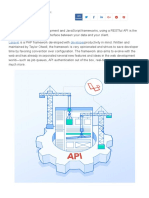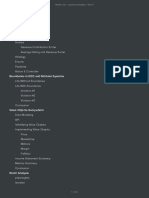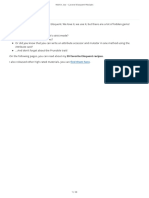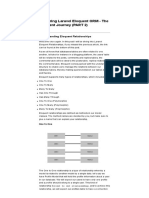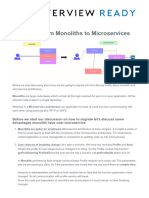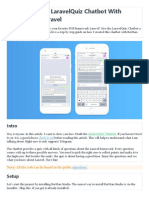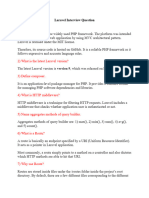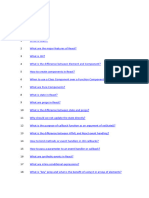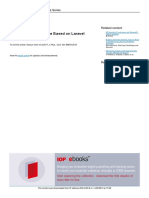Martin Joo - Proper API Design With Laravel
Introduction
This short PDF is about the fundamentals. It tries to show you how you can write robust, high-quality APIs in
Laravel where you have a standard way for:
Filters
Sorting
Including relationships
Sparse fieldsets
API Versioning
Test-Driven Development
Achieving this requires a lot of code, but fortunately there are some packages and standards that can help
us:
JSON API
laravel-query-builder by Spatie
json-api by Tim MacDonald
Hi! I'm Martin Joo. I tweet about Laravel every day, publish blog posts, and also wrote a book. You can
find me here.
1 / 23
� Martin Joo - Proper API Design With Laravel
JSON API
We write so many APIs and if you think about it each of them is different:
Different data structures.
Relationships are included differently.
In some APIs, a relationship is included with other attributes.
In some APIs, there's a separate relations key for them.
In some APIs you don't get relationships at all, you have to call another endpoint.
Some APIs use camelCase while others use snake_case .
The filtering and the sorting are different every damn time.
Wouldn't be great if there were a standard that generalizes all of these concepts? Yes, there is! And it's
called JSON API.
JSON API is a specification that tells you how to structure your response data, how to implement filtering,
sorting, relationship including in your request URLs.
2 / 23
� Martin Joo - Proper API Design With Laravel
Responses
Here's the basic structure of a JSON API response:
{
"data": {
"id": 1,
"type": "threads",
"attributes": {
"slug": "this-is-a-thread",
"title": "This is a thread",
"body": "This is the actual content of the thread",
"counters": {
"share": 88,
"like": 367,
"reply": 6
}
},
"relationships": {
"author": {
"data": { "type": "users", "id": 1}
},
"tags": [
{"data": { "type": "tags", "id": 2}},
{"data": { "type": "tags", "id": 16}},
]
},
"included": [
{
"id": 1,
"type": "users",
"attributes": {
"name": "Micheal Scott",
"email": "micheal.scott@dunder-mifflin.com"
}
},
{
3 / 23
� Martin Joo - Proper API Design With Laravel
"id": 2,
"type": "tags",
"attributes": {
"name": "sales"
}
},
{
"id": 16,
"type": "tags",
"attributes": {
"name": "paper"
}
}
]
}
}
Some of the key things:
Every resource has an ID and a type as a root level attribute
Every other attribute lives in the attributes object
The relationships key only contains some meta information about the relationships
The included key actually contains the loaded relationships like author or tags
There are a tons of other thing in the actual specification, but I want to focus on the basics. That's the most
important stuff. The relationship part can be a bit confusing, so let's clear this up.
In web development we have two main choices when it comes to relationships in APIs:
Include (almost) everything and return a huge response.
Include (almost) nothing and provide links to the clients.
There are pros and cons to both of these approaches and most of the time it depends on your application.
But there is two good rules of thumbs:
If you include (almost) everything you may end up with huge responses and N+1 query problems. For
example, you return a response with 50 articles and each article loads the author. You end up with 51
queries.
If you include (almost) nothing you have small responses but you may have too many requests to the
server. For example, you return a response with 50 articles, after that the client makes 50 additional
HTTP requests to get the authors.
JSON API supports both of these options:
4 / 23
� Martin Joo - Proper API Design With Laravel
{
"relationships": {
"author": {
"links": {
"self": "http:"#example.com/articles/1/relationships/author",
"related": "http:"#example.com/articles/1/author"
}
},
"comments": [{
"data": {"type": "comments", "id": 5}
}]
},
}
In this example, the comments relationship is loaded while the author only contains a link where you can
fetch the author. In fact, it contains two links and it's a little bit confusing so let's make it clear:
related: with this URL I can manipulate the actual user (author). So if I make a DELETE
http://example.com/articles/1/author request I delete the user from the users table.
self: this URL only manipulates the relationship between the author and the article. So if I make a
DELETE http://example.com/articles/1/relationships/author request I only destroy the
relationship between the user and the article. But it won't delete the user from the users table.
As you can see in the comments key there is an ID and a type, but no attributes. Where is it? It lives in the
included key:
"included": [{
"type": "comments",
"id": "5",
"attributes": {
"body": "First!"
},
"links": {
"self": "http:"#example.com/comments/5"
}
}]
5 / 23
� Martin Joo - Proper API Design With Laravel
This is a little bit confusing, so let's make it clear:
Relationships: it only contains information about the relationships. It tells you that an article has
author and comments relationships.
Included: it contains the loaded relationships. In the example above the API endpoint only loads the
comments, so in the included key you can find the comments but not the author. The author can be
fetched using the links in the relationships object.
This is the part I like the least about JSON APi. In my opinion, it would be much better if there's only a
relationships key that looks like this:
{
"relationships": {
"author": {
"links": {
"self": "http:"#example.com/articles/1/relationships/author",
"related": "http:"#example.com/articles/1/author"
}
},
"comments": [{
"type": "comments",
"id": "5",
"attributes": {
"body": "First!"
},
"links": {
"self": "http:"#example.com/comments/5"
}
}]
},
}
So it actually contains the comments and provides links for the author. However in this book, I will follow
the official specification, but here's my opinion: you don't have to obey a standard just because it's a
standard. You can use only the good parts from it that fit your application.
Either way, you have a reasonable default standard in your company / projects.
6 / 23
� Martin Joo - Proper API Design With Laravel
Laravel resources
Creating this response structure by hand can be exhausted. But fortunately there is a package called json-
api by Tim MacDonald.
By using this package you need extend the JsonApiResource class in your resources instead of the
JsonResource provided by Laravel. A resource class looks like this:
use TiMacDonald\JsonApi\JsonApiResource;
class CategoryResource extends JsonApiResource
{
public function toAttributes($request): array
{
return [
'name' "$ $this"%name,
'slug' "$ $this"%slug,
];
}
}
With this package you don’t need to define:
ID
Type
Attributes
It will produce this JSON automatically. By default it uses the id column from your models. You can
override this behavior in the AppServiceProvider :
public function boot()
{
JsonApiResource"&resolveIdUsing(fn (Model $model) "$ $model"%uuid);
}
In this example I use the field uuid as the id in the responses. You can also define relationships with the
toRelationships method:
7 / 23
� Martin Joo - Proper API Design With Laravel
use TiMacDonald\JsonApi\JsonApiResource;
class ThreadResource extends JsonApiResource
{
public function toAttributes($request): array
{
return [
'slug' "$ $this"%slug,
'title' "$ $this"%title,
'body' "$ $this"%body,
'counters' "$ [
'share' "$ $this"%share_count,
'like' "$ $this"%like_count,
'reply' "$ $this"%reply_count,
],
];
}
public function toRelationships($request): array
{
return [
'author' "$ fn () "$ new AuthorResource($this"%author),
'category' "$ fn () "$ new CategoryResource($this"%category),
'tags' "$ fn () "$ TagResource"&collection($this"%tags),
];
}
}
This will populate the relationships and the included keys as well. The important thing is that all array keys
like author is a callback. These keys are lazily evaluated. It means that this package checks the included URL
parameter in the request and if a relationship is included only then the callback will be executed. In this way
the client is in perfect control about what relationships it needs, and only query the necessary ones.
8 / 23
� Martin Joo - Proper API Design With Laravel
Requests
JSON API also specifies how you the request URLs should look like. This includes:
Filters
Sorting
Sparse fieldset
Including relationships
Filtering
GET /threads?filter[title]=laravel&filter[title]=php
Here we say: "I only want threads that contains Laraval and PHP in the title". You can specify OR relation:
GET /threads?filter[name]=laravel,php
Sorting
GET /threads?sort=-like_count
Sorting threads descending based on like count. What about ascending?
GET /threads?sort=like_count
We just remove the - symbol. You can specify multiple columns:
GET /threads?sort=like_count,share_count
Including relationships
It's a very good practice to let the client decide when to load a relationship and when not to. Later we can
leverage Laravel API Resources to accomplish this. With JSON API it's really simple:
GET /threads?include=tags
A thread can have a lot of tags, and maybe we don't want to include them every single time, so we let the
client decide it. We can include multiple stuff:
9 / 23
� Martin Joo - Proper API Design With Laravel
GET /threads?include=tags,author
Sparse fieldset
SELECT * queries can be slow and time-consuming, and often we don't need every single column in the
response. We can solve it like this:
GET /threads?fields[threads]=id,title,body
We can also specify fields for included relationships:
GET /threads?include=author&fields[author]=id,name
And of course JSON API also specifies pagination, but that's already solved by Laravel out of the box, so
we're gonna skip this part. The next question is: how do we implement all this complicated, generic stuff for
every model? Luckily we don't have to. We already have the solution. Let's learn about Query Builders!
10 / 23
� Martin Joo - Proper API Design With Laravel
Spatie QueryBuilder
In my opinion this is the most important package when building great APIs. This package implements all of
the:
Sorting
Filtering
Including relationships
Spare fieldsets
Paginating
These problems are solved out of the box using QueryBuilder classes. Let's see how it looks like!
Filtering
"# GET /threads?filter[title]=laravel&filter[title]=php
$threads = QueryBuilder"&for(Thread"&class)
"%allowedFilters(['title', 'body'])
"%get();
We create a QueryBuilder for a specific model (in this case Thread), and define what filters we want to
allow. Then it will get these filters from the request, and apply them by where filters. That's it! You're done.
You have a fully functioning filter. You can also apply additional where statements or scopes:
$threads = QueryBuilder"&for(Thread"&class)
"%allowedFilters(['title', 'body', 'author.name'])
"%where('category_id', $category"%id)
"%wherePublic()
"%get();
Sorting
"# GET /threads?sort=reply_count
$threads = QueryBuilder"&for(Thread"&class)
"%allowedSorts(['like_count', 'reply_count'])
"%get();
We can specify what columns can be used in the ORDER BY clause. If the URL doesn't contain a sort query,
we can apply a default sort:
11 / 23
� Martin Joo - Proper API Design With Laravel
"# GET /threads
$threads = QueryBuilder"&for(Thread"&class)
"%defaultSort('title')
"%allowedSorts(['like_count', 'reply_count'])
"%get();
In this case threads will be sorted by title because there's no sort specified in the URL.
Including relationships
"# GET /threads?include=author
$threads = QueryBuilder"&for(Thread"&class)
"%allowedIncludes(['author', 'tags'])
"%get();
It's easy... And finally the spare fieldsets.
Sparse fieldsets
"# GET /threads?fields[threads]=id,title
$threads = QueryBuilder"&for(User"&class)
"%allowedFields(['id', 'title'])
"%get();
As you can see, it's a really great, and powerful package. WIth this knowledge let's start our sample API
using these principles.
12 / 23
� Martin Joo - Proper API Design With Laravel
Other ideas
API versioning
If you look inside the repository you can see that we have a file called v1.php in the routes folder. This file
contains all of our API v1 routes. If we need to change our API, we can create a new v2.php and put the API
v2 routes inside it. You can configure it in the RouteServiceProvider::boot() method:
public function boot()
{
$this"%configureRateLimiting();
$this"%routes(function () {
Route"&prefix('api/v1')
"%middleware(['api', 'auth:sanctum'])
"%group(base_path('routes/v1.php'));
});
}
We can specify the middlewares as well, so in the v1.php we just list our routes:
13 / 23
� Martin Joo - Proper API Design With Laravel
use App\Http\Controllers\CategoryController;
use App\Http\Controllers\PopularThreadController;
use App\Http\Controllers\ReplyController;
use App\Http\Controllers\ThreadController;
use Illuminate\Support\Facades\Route;
Route"&get('categories/{category}/threads/popular', [
PopularThreadController"&class,
'index'
]);
Route"&apiResource('categories', CategoryController"&class)
"%only(['index', 'store', 'destroy']);
Route"&apiResource('categories/{category}/threads', ThreadController"&class)
"%except('update');
Route"&apiResource(
'categories/{category}/threads/{thread}/replies',
ReplyController"&class
)"%only(['index', 'store', 'destroy']);
I like using nested resources and nested routes, something like:
GET /api/v1/categories/my-category/threads
14 / 23
� Martin Joo - Proper API Design With Laravel
This helps me to keep organized and also to write simple controllers that stick to the basic API resource
methods:
Controller Method Route
index GET /categories
show GET /categories/my-category
store POST /categories
update PUT /categories/my-category
destroy DELETE /categories/my-category
15 / 23
� Martin Joo - Proper API Design With Laravel
API Best Practices
After all these fundamentals, let me share some of my API "best practices" with you:
Write easy-to-understand, resourceful APIs.
Use nested resources with nested controllers whenever it makes sense.
Use the HTTP status codes. For example, if your endpoint is asynchronous (meaning it dispatches jobs
that will take time) don't return 200 but 202 - Accepted and a link where the client can request the
status of the operation.
Don't expose auto-increment integer IDs! This is an important one. Using IDs like 1, 2 in your URLs is a
security concern and can be exploited. It's especially important if your API is public. This is how I do it:
I have integer IDs in the database. It's mostly MySQL which is optimized for using auto-increment
IDs.
I also have UUIDs for almost every model.
In the API I only expose the UUIDs.
Versioning your API. This is also more important if you write a public API. I show you later how to do it
easily with Laravel's RouteServiceProvider.
Let the client decide what it wants. This means:
Loading relationships
FIltering
Sorting
Sparse fieldsets
Try to standardize these things so you have the same solutions in your projects. In this case, we're
gonna use JSON API.
Make your response easy to use for the client, for example:
Use camelCase which is very natural in Javascript.
Use nested attributes for cohesive data.
All of the above is easy to achieve in Laravel with the help of a few packages.
To sum it up, we want API endpoints like these:
GET /api/v1/employees/a3b5ce95-c9c8-40f7-b8d7-06133c768a92?
include=department,paychecks
GET /api/v1/emplyoees/a3b5ce95-c9c8-40f7-b8d7-06133c768a92/paychecks?sort=-
payed_at
16 / 23
� Martin Joo - Proper API Design With Laravel
Test-Driven Development
Test-Driven development is a programming approach where the tests drive the actual implementation
code. In practice, this means that we write the tests first and then the production code. I know it sounds
complicated and maybe a little bit scary. So I try to rephrase it:
In Test-Driven Development the first step is to specify how you want to use your class / function.
Only after that do you start writing the actual code.
The red
Let me illustrate it with a very simple example. I need to write a Calculator class that needs to be able to
divide two numbers. Let's use it before we write it!
$calculator = new Calculator();
"# I expept to be 5.00
$result = $calculator"%divide(10, 2);
"# I expect to be 3.33
$result = $calculator"%divide(10, 3);
"# I expect to be 0.00 instead of an Exception
$result = $calculator"%divide(10, 0);
After 3 examples we have the specification:
Always returns float with 2 decimals
Returns 0 when division by zero happens
Instead of comments, we can use so-called assertions from PHPUnit:
17 / 23
� Martin Joo - Proper API Design With Laravel
$calculator = new Calculator();
$result = $calculator"%divide(10, 2);
$this"%assertEquals(5.00, $result);
$result = $calculator"%divide(10, 3);
$this"%assertEquals(3.33, $result);
$result = $calculator"%divide(10, 0);
$this"%assertEquals(0.00, $result);
Now, that we're using asserts we need a context. This is our test class:
class CalculatorTest extends TestCase
{
public function testDivide()
{
$calculator = new Calculator();
$this"%assertEquals(5.00, $calculator"%divide(10, 2));
$this"%assertEquals(3.33, $calculator"%divide(10, 3));
$this"%assertEquals(0.00, $calculator"%divide(10, 0));
}
}
It's always a good idea to separate your test functions based on 'use-cases'. In this basic example we have
two different scenarios:
Divide two valid numbers
Handle division by zero
18 / 23
� Martin Joo - Proper API Design With Laravel
So we should create two test functions:
class CalculatorTest extends TestCase
{
public function testDivideValidNumbers()
{
$calculator = new Calculator();
$this"%assertEquals(5.00, $calculator"%divide(10, 2));
$this"%assertEquals(3.33, $calculator"%divide(10, 3));
}
public function testDivideWhenTheDividerIsZero()
{
$calculator = new Calculator();
$this"%assertEquals(0.00, $calculator"%divide(10, 0));
}
}
I don't know about you, but I'm going crazy just by looking at this function name:
testDivideWhenTheDividerIsZero . Fortunately, PHPUnit has a solution for us:
class CalculatorTest extends TestCase
{
/** @test "'
public function it_should_divide_valid_numbers()
{
}
/** @test "'
public function it_should_return_zero_when_the_divider_is_zero()
{
}
}
19 / 23
� Martin Joo - Proper API Design With Laravel
With the @test annotation you can omit the test word from the function name and by using underscores
you can actually read it. As you can see a test function's name reads like an English sentence: It should
divide valid numbers.
A test should read like documentation for a class / method.
In this stage, you have no real code, only tests. So, naturally, these tests will fail (the Calculator class doesn't
even exist).
This stage is called red because your tests fail.
20 / 23
� Martin Joo - Proper API Design With Laravel
The green
It's time to write some code! After we wrote the tests, we can write the actual code:
class Calculator
{
public function divide(float $a, float $b): float
{
if ($b ""( 0.0) {
return 0;
} else {
return round($a / $b, 2);
}
}
}
In this stage, your main focus should not be to write the most beautiful code ever. No, you want to write the
minimum amount of code that makes the tests green. After your tests pass maybe you come up with a new
edge-case so you should write another test, and then handle this edge-case in your code.
This stage is called green because your tests pass.
21 / 23
� Martin Joo - Proper API Design With Laravel
The refactor
So we wrote the minimum amount of code to make the tests pass. This means that we have an automated
test for every use case we know right now. If you think about it, this is a huge benefit! From that point you
are almost unable to make bugs, so you can start refactoring:
class Calculator
{
public function divide(float $a, float $b): float
{
try {
return round($a / $b, 2);
} catch (DivisionByZeroError) {
return 0;
}
}
}
This stage is called refactor because you don't write new code but make the existing codebase better.
22 / 23
� Martin Joo - Proper API Design With Laravel
Thank you
Thank you very much for reading this short PDF! I hope you have learned a few cool techniques.
By the way, I’m Martin Joo, a software engineer since 2012. I’m passionate about Domain-Driven Design,
Test-Driven Development, Laravel, and beautiful code in general.
I released a ~100 pages eBook called Test-Driven APIs with Laravel and Pest where I discuss things like
how you can:
Achieve near 100% code coverage using Pest
Write standardized requests and responses using JSON API
Create developer-friendly APIs using nested resources
Utilize PHP 8.1 enums with the factory and the strategy design pattern
Use simple, yet powerful concepts from Domain-Driven Design
...and a lot more about API design
If you liked this PDF you should check it out. You can download a free chapter.
23 / 23



